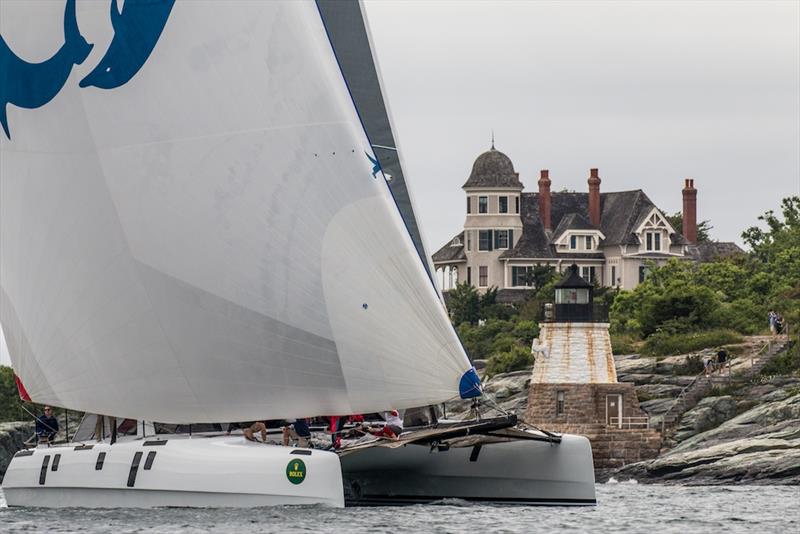
Embracing sailing’s adventurous side on both coasts
by David Schmidt 12 Jun 2018 05:00 NZST
June 14, 2018

Boats such as the Gunboat 60, Arethusa, will sail in the Newport Bermuda Race's first Multihull Division in 2018 © Rolex / Daniel Forster
While there's no question that Windward-Leeward courses are the purest form of round-the-buoys competition, these races sometimes feel a bit formulaic, especially for those in our tribe who are more interested in sailing's adventurous side than its methods of determining the most polished and prepared teams on the starting line. Enter the Race to Alaska (R2AK), which began in 2015 as a quest to see if it would be possible to race human-powered vessels from the sleepy sailing town of Port Townsend, Washington, to Ketchikan, Alaska, a distance of 750 nautical miles, sans support or internal-combustion engines.
R2AK teams have always been allowed to choose their own vessel, so long as it doesn't carry auxiliary power, and a groundswell debate began on docks across the country in late 2014/early 2015 as to what the fastest horse for the R2AK course would be. Impressively, teams have thrown everything from monohulls, multihulls, and SUPs to a Proa sailing canoe with an outrigger ama that "shunted", rather than tacked, through the wind (it's possible I'm intimately familiar with this one), at the problem, with some fairly conniving results.
Not surprisingly, given the light airs and strong tides that can sometimes define this course in mid-June, multihulls proved to be the hot ticket from the onset, with a trimaran taking top honors in 2015, followed by a catamaran in 2016 and another trimaran in 2017.
Based on this logic, one would assume that the entire 2018 fleet would be attempting to fly one or more hulls en route to Alaska, but - given that this is the R2AK, not a One Design or handicap regatta - one would be wrong. In fact, out of the 38 registered entrants (at the time of this writing) for the 2018 R2AK, which starts on Thursday, June 14 in Port Townsend and sails to the charming coastal town of Victoria, British Columbia (read: a 40 nautical mile "proving ground" shakedown cruise) before continuing on to Ketchikan, only seven boats have three hulls, six have two hulls, 19 have keels and six are board-type or oar-powered vessels.
So, while the seven trimarans and six catamarans battle to see who will take home the $10,000 in cash that the race organizers famously nail to a tree (or a chunk of wood), as well as the set of R2AK steak knives (read: consolation cutlery), the rest of the fleet will be contending with huge tides, whales, bald eagles, cruise ships and other heavy metal, not to mention possible grizzly bear sightings, in addition to "character-building weather" that can range from glassy to boisterous, with plenty of fast-changing grey in between.
If that sounds like a whole lot of adventure and not a lot of polished racing, welcome to the Pacific Northwest, a place where the mountains are big and the ocean is significantly bigger still.
Speaking of adventure racing and multihulls, the 2018 Newport Bermuda Race, co-organized by Cruising Club of America and Royal Bermuda Yacht Club, is set to begin on Friday, June 15 from a start provided by the New York Yacht Club, and will take the fleet of 171 registered boats (at the time of this writing) some 635 bluewater miles to the island nation of Bermuda, crossing the infamous Gulf Stream en route.
While the bulk of the fleet carries leaded ballast, 2018 marks the first time in this biennial regatta's storied 112-year history that multihulls have been allowed to race to Bermuda, and this year there are three catamarans racing, namely Arethusa, Elvis, and Tribe, all of which are Gunboats ranging in LOA from 60-62 feet.
Interestingly, there are a number of teams racing monohulls to Bermuda that are loaded with junior-aged sailors who are keen to learn the ropes of offshore sailing, as well as five boats registered to Oakcliff Sailing, including three Farr 40 Turbos, a Cookson 50, and a JV66 (nee Numbers). For example, both Dreamcatcher, a donated Swan 48 that will be sailed by the MudRatz, a Connecticut-based youth sailing organization, and Feo, a Joshua 47 that's racing in the Finisterre Division (formerly the Cruising Division), will be sailed by crews of youngsters calling the shots, while Young American - Gambler, a Reichel/Pugh 63, will be raced by a crew of 16 that mostly includes college-aged sailors connected to the Young American Sailing Academy.
And while it's still too early to get meaningful forecasts for the "Thrash To The Onion Patch", as the race is sometimes called, there's no question that all competing sailors will experience some form of adventure as they cross 635 bluewater miles.
Sail-World.com wishes safe, successful and fast passages to all crews, sailors and adventurers participating in both the time-honored Newport Bermuda Race and the R2AK.
May the four winds blow you safely home,
David Schmidt, Sail-World.com North American Editor